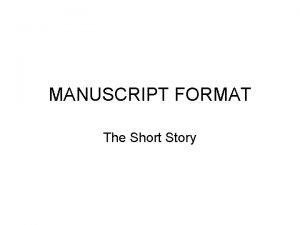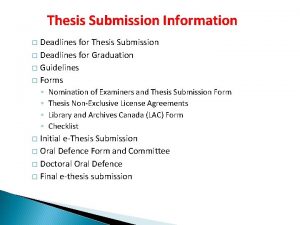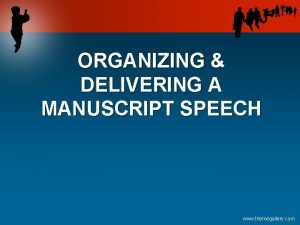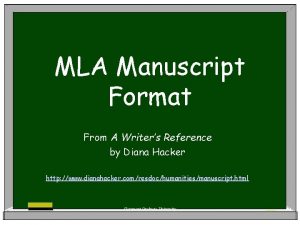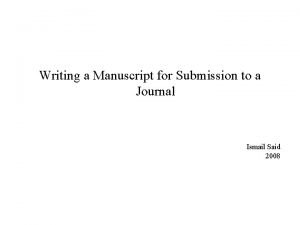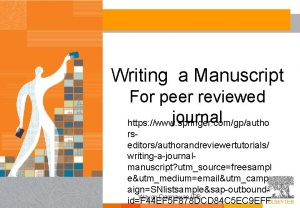Manuscript Writing When Journal Selection How do you











![Figure 1. Ang II stimulates an increase in [Ca 2+]i in Neuro-2 A cells. Figure 1. Ang II stimulates an increase in [Ca 2+]i in Neuro-2 A cells.](https://slidetodoc.com/presentation_image_h2/3a742d62dbba29579fca8529ac899ac2/image-12.jpg)












- Slides: 24

Manuscript Writing • • When ? Journal Selection How do you write a manuscript? Review, Response, Resubmission Colin Sumners, Ph. D July 15, 2015

When do you write a manuscript? • When you are excited about your findings and want to publish them! • When you have enough data Ø Statistically sound data Ø Scientifically sound data Ø Does the data prove/disprove your hypothesis • When all of your co-authors are in agreement with the findings • When your boss tells you to! • It is important to have your data published before applying for grants

Journal Selection • Type of Journal Ø General (Science; Nature; Cell) Ø Discipline ü Specialty (J. Neuroscience; Am. J. Physiology) ü Sub-specialty (Cytokine; Peptides; Antioxidants) Ø Does the journal fit your work? • Type of Manuscript Ø Full paper Ø Brief/Rapid/Accelerated Communication Ø Letter • Journal Impact factor

Journal Impact Factor • • Journal Impact Factor (JIF) is from Journal Citation Report (JCR), a product of Thomson ISI (Institute for Scientific Information). JCR provides quantitative tools for ranking, evaluating, categorizing, and comparing journals. The impact factor is one of these; it is a measure of the frequency with which the "average article" in a journal has been cited in a particular year or period. JIF is a commonly used by researchers as an index of “how good a journal is” Calculation (from http: //www. sciencegateway. org/impact/) Ø The impact factor for a journal is calculated based on a three-year period, and can be considered to be the average number of times published papers are cited up to two years after publication. For example, the impact factor 2014 for a journal would be calculated as follows: ² A = the number of times articles published in 2012 -2013 were cited in indexed journals during 2014 ² B = the number of articles, reviews, proceedings or notes published in 20122013 ² Impact factor 2014 = A/B Lots of Pros and Cons for relying on JIFs Ø P. O. Seglen. Why the impact factor of journals should not be used for evaluating research. BMJ 314: 497 (1997) Ø Does it measure Quality?

How do you write a manuscript? Where to begin • Read the journal instructions carefully Ø Journal scope. Is this the correct place to submit your work? Ø Make sure you understand the page/section/data figure limitations Ø Make sure you understand the format (manuscript layout; text format; format for citing literature) Ø Understand the requirements for submitting articles/data figures/pictures electronically

How do you write a manuscript? Full Paper Layout (Usual) • • • Title Page/Authors Abstract Introduction Methods (can sometimes be supplemental or at the end of the article) Results Discussion Acknowledgements Literature Cited Figure Legends Figures (Submitted as separate files or included with the ms)

How do you write a manuscript? One approach to manuscript writing • • • Results Figures and Figure Legends Methods Introduction Discussion Literature Cited Title Page/Authors Abstract Acknowledgements

How do you write a manuscript? The Results Section This is where you present your data! Tips: • Before you begin to write, plan the sequence in which you will present your data. • The sequence in which you present your data is that which makes most sense logically, and allows you to “tell a story”. • The sequence in which you present your data is often not the order in which you did the experiments. • Be clear, concise and straightforward, but make sure that you adequately describe the protocols

How do you write a manuscript? The Results Section, contd. This is where you present your data! Tips: • Try to include transition statements from one sub-section to another (this often includes statement of a rationale when starting a new sub-section) • Make sure that what is said in the results text matches the data shown in the Figures • Try not to weave Discussion points into this section (e. g. “The data shown in Figure 1 indicates that Ang II increases MIF expression in neurons. This may mean that…. . ” • Do not include Conclusions here

How do you write a manuscript? Figures & Legends A critical part of your manuscript. Often what people look at first or second. Tips: • Make them clear, not too crowded • Use a large enough font so that when they are reduced in size for the journal you can actually read them! • You can always do multi -panel figures • Make sure that the Legends are sufficiently detailed • Make sure that “Representative data” matches the Mean or Summary data, e. g. ….

How do you write a manuscript? Figures, Contd. Correct matching of “Representative” and “Summary” data.
![Figure 1 Ang II stimulates an increase in Ca 2i in Neuro2 A cells Figure 1. Ang II stimulates an increase in [Ca 2+]i in Neuro-2 A cells.](https://slidetodoc.com/presentation_image_h2/3a742d62dbba29579fca8529ac899ac2/image-12.jpg)
Figure 1. Ang II stimulates an increase in [Ca 2+]i in Neuro-2 A cells. Zimmerman M C et al. Hypertension. 2005; 45: 717 -723 Copyright © American Heart Association, Inc. All rights reserved.

How do you write a manuscript? Methods This section describes, in technical terms, the procedures that you used in your study Tips: • Include a Materials section • Be brief where possible. If you have previously published a Method, then make a statement such as “Macroscopic K+ current was measured as detailed by us previously (1)” • For Methods that you have not previously published, provide details. • Details of anesthesia, if surgeries are performed.

How do you write a manuscript? Methods, contd. This section describes, in technical terms, the procedures that you used in your study Tips: • For animal studies in particular, it is useful to provide details of the Experimental Protocols that were followed. • You must include the numbers of animal/human subjects used, and a statement that you had IACUC/IRB approval to perform the studies, and followed all the guidelines. • Include statistical analyses. • You might be able to include most of the Methods as a Supplement

How do you write a manuscript? Introduction In this part of the manuscript you set the stage for presenting your data. Tips: • Begin with a few lines/paragraph that covers the general area that you are studying (stroke; hypertension; obesity; …etc. ). • How is the renin-angiotensin system related to stroke, in general terms? • Focus on the subject of your study…Angiotensin-(1 -7). Discuss briefly its protective actions in the cardiovascular system.

How do you write a manuscript? Introduction, contd. In this part of the manuscript you set the stage for presenting your data. Tips: • Describe studies which show that Angiotensin-(1 -7) is protective in ischemic stroke. • Develop a hypothesis…”Based on the literature, we developed the hypothesis that Angiotensin-(1 -7) may be neuroprotective in hemorrhagic stroke. • Here, we investigated ………the effects of Angiotensin-(17) in hemorrhagic stroke. Outline here, what you did to test your hypothesis, but not the results.

How do you write a manuscript? Discussion Here is where you discuss your data and how it relates to what is already known. Tips: • Begin by re-capping the major findings of your study. Emphasize the novelty of your findings. • Do your findings fit with what is already known? Discuss similarities & differences, citing pertinent references (your own studies, and studies from other groups). • Do your findings fit with your original hypothesis? If so, re -state your hypothesis. If not, reformulate your ideas. • What avenues for new research have your studies opened up?

How do you write a manuscript? Discussion, contd. Here is where you discuss your data and how it relates to what is already known. Tips: • What questions were raised by your study? • Speculation…. . Speculate as far as your data allows. Too much speculation is easy fodder for reviewers. • “Perspectives”. Some journals require a section where you relate your findings globally to your area of research, and to human health. • Summary & Conclusions

How do you write a manuscript? . . . Literature Cited/References This can be a pain! Tips: • It seems as if most journals have a different format for references!! • Within publishing companies, reference formats are normally the same, but not always. • Use a program such as End. Note, Reference Manager, Refworks as you write your manuscript. • If not, have a good secretary.

How do you write a manuscript? . . . Title Page This is the first thing that people will see when searching on Pub. Med Tips: • Journals usually limit the number of letters within a title. • Make it direct, describing the main finding of your results, instead of saying what you did. • For example… “Centrally administered angiotensin-(1 -7) increases the survival of stroke-prone spontaneously hypertensive rats. ” not…. . “Effects of centrally administered angiotensin-(1 -7) on the survival of stroke-prone spontaneously hypertensive rats. ”

How do you write a manuscript? . . . Abstract This is the third thing that people will see when searching on Pub. Med Tips: • There is normally a strict word limit, 200 or 250 words. • Try to summarize your study, including the methods/approaches used, findings and conclusions, …. • …. . without going into details (unless requested by the journal)

How do you write a manuscript? . . . Authors/Acknowledgements Authors are the second thing that people will see when searching on Pub. Med Tips: • Authors should have made a significant contribution to the study and understand it. Otherwise list people in the acknowledgements. • Many journals now require you to state exactly what each listed author did (Developed the idea; Study design; Performed experiments; Data analysis; Wrote the paper…etc. ). • Who is first? Who is the senior author? Everyone must approve it and sign a consent/copyright form. • Acknowledgements: Grant funding (very important); individuals who contributed but don’t warrant (or want) authorship.

Review, Response, Resubmission…. . Review • It may take from 1 day to 2 months to receive a review of your manuscript! • Most high impact journals get the job done quickly. Some very quickly--- they make an Editorial decision that your study is not suitable for their journal. • You will receive an email for the journal editor informing you of the overall decision. For example: Accept with minor revisions; Reconsider after major revisions; Reject. . • You may be required to do more experiments. • You have to make the decision whether to re-submit to the same journal (if invited to do so), or try elsewhere.

Review, Response, Resubmission…. . Response & Resubmission Comments may be easy to deal with, or much more difficult, ……. Tips: • Straightforward comments, even those that require more experimentation, are relatively easy to deal with. • The tougher ones are where the reviewer disagrees with your point of view, or your interpretation. • The really difficult ones are where the reviewer is antagonistic, condescending, superior. • In the latter case, it never works to be antagonistic back. Find a way to tell them they are wrong (including literature evidence) and that if they had only read the paper carefully. . • The question of a particularly antagonistic review can also be addressed in your letter to the Editor upon resubmission.
 Medical manuscript writing
Medical manuscript writing Ieee ias manuscript central
Ieee ias manuscript central Manuscript format short story
Manuscript format short story Illuminated manuscript font
Illuminated manuscript font Thesis defense introduction script
Thesis defense introduction script Manuscript for speech
Manuscript for speech A writers reference
A writers reference Manuscript delivery
Manuscript delivery Endnote manuscript matcher
Endnote manuscript matcher Bahan tulisan
Bahan tulisan Mike filsaime butterfly marketing
Mike filsaime butterfly marketing Manuscript speech
Manuscript speech Nnn speech
Nnn speech Manuscript speech
Manuscript speech Balancing selection vs stabilizing selection
Balancing selection vs stabilizing selection Similarities
Similarities K selection r selection
K selection r selection Natural selection vs artificial selection
Natural selection vs artificial selection Artificial selection vs natural selection
Artificial selection vs natural selection Disruptive selection
Disruptive selection Clumped dispersion
Clumped dispersion Natural selection vs artificial selection
Natural selection vs artificial selection Two way selection and multiway selection in c
Two way selection and multiway selection in c Multiway selection
Multiway selection Mass selection and pure line selection
Mass selection and pure line selection


